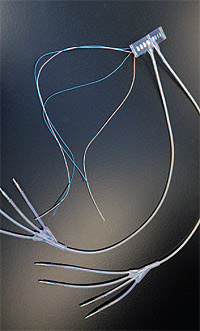Advanced Platform Technology Center
Model-driven Design of Optimal Electrodes and Stimulation
 Research with human volunteers is essential to establishing the performance of neural interfaces. However, there are far more design options and configurations than are possible to test experimentally in humans. Computer simulations offer an alternative method to evaluate and select the most effective design options for clinical application.
Research with human volunteers is essential to establishing the performance of neural interfaces. However, there are far more design options and configurations than are possible to test experimentally in humans. Computer simulations offer an alternative method to evaluate and select the most effective design options for clinical application.
APT Center Investigators are applying finite element method computer models to simulate the complicated spread of electric current throughout realistic, histologically-derived, 3D representations of human nerves.
Biomechanical models are also being combined with these neural models to predict the functional outcomes that can be expected at the muscle or joint level. Using statistical methods, the optimal size, shape, number and distribution of contacts and within a nerve cuff electrode can be determined. These computer simulations have allowed the cuff to be appropriately designed for each target nerve, balancing the engineering and manufacturing constraints with the clinical requirements. This in silica technique has been applied to the human femoral to restore the knee extension needed for standing, and the human sciatic, tibial, and common fibular nerves to restore the ankle motion needed for walking. In the upper extremity similar modeling techniques have employed genetic algorithms to maximize the ability to generate finger and wrist motion with a minimal number of contacts. The results of both of these simulation-driven studies have been confirmed experimentally; further documenting that use of computer simulations can accelerate the rate and reliability of translating technologies into clinical trials.
Principal Investigators: Matthew Schiefer, Ph.D. • Ronald Triolo, Ph.D.• Dustin Tyler, Ph.D.
Funding Agency: National Institutes of Health
Photo: Splayed nerve cuff




















